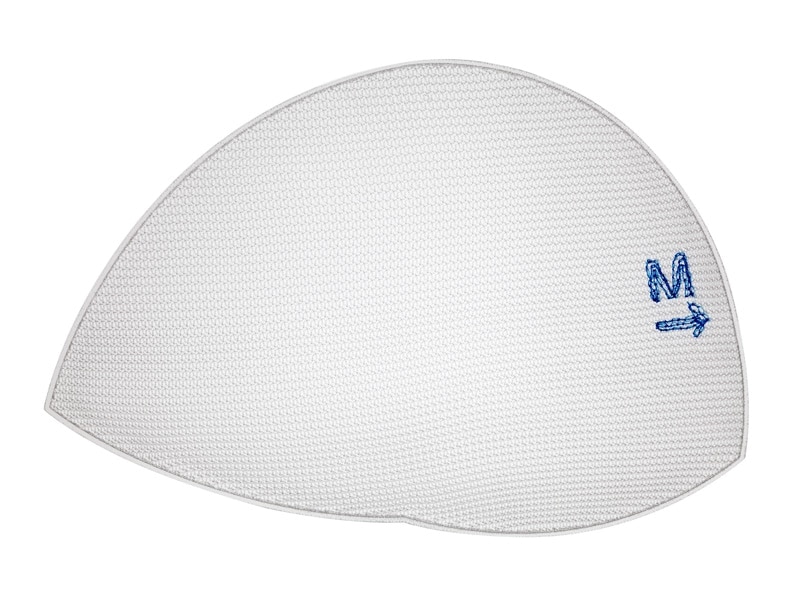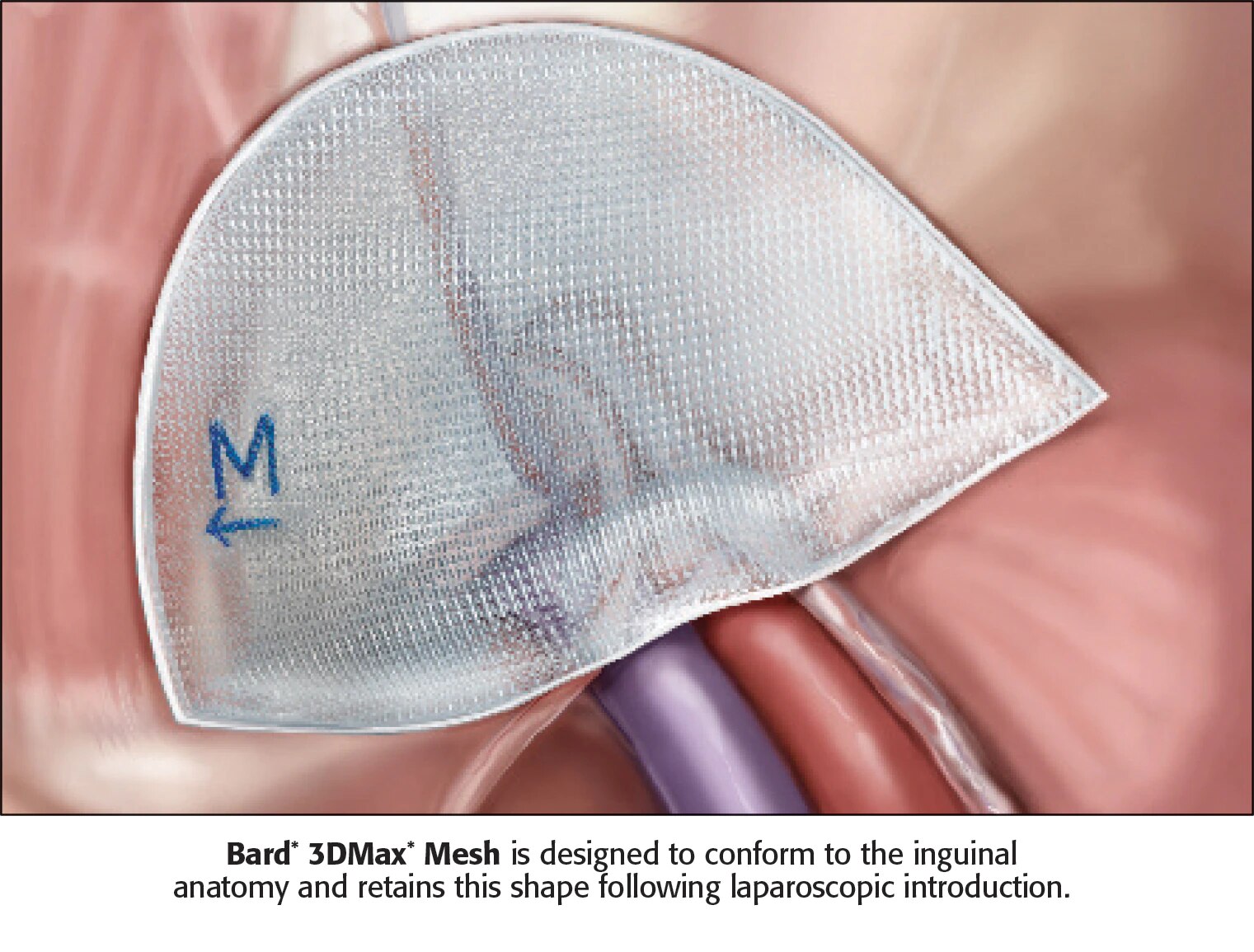RELATED PRODUCTS NOT AVAILABLE
true
Support
Sales
1.844.8.BD.LIFE (1.844.823.5433)
Thank you for contacting our sales team!
A sales representive will get in touch with you shortly.
Ordering
1.800.556.6756
BDISurgery@bd.com
Onsite Visiting
100 Crossings BoulevardWarwick, Rhode Island 02886United States
Customer Service
1.844.8.BD.LIFE (1.844.823.5433)
Monday to Friday 8:15 AM to 6:00 PM EST
1.800.531.4124
Custserv.davol@bd.com
Shipping a Product Back
100 Crossings Boulevard, Warwick, Rhode Island 02886, United States
3DMax™ Mesh
Unique three-dimensional polypropylene mesh for laparoscopic inguinal hernia repair.



- Overview
- Products & Accessories
- EIFU & Resources
false
Anatomically Designed
Fully contoured mesh designed to conform to the inguinal anatomy.
Easy Positioning
Sealed edge and medial orientation marker are designed to ensure an anatomically correct fit and less wrinkling than conventional flat mesh.
Fixation-Free Repair
Eliminates need for fixation, which saves time and money.
Reduced Patient Pain
Patients who received Bard 3DMax™ Mesh without fixation used significantly less narcotic analgesia in the immediate postoperative period than those in whom flat mesh was fixated.2
Compatible with Various Laparoscopic Approaches
- TAPP
- TEP
- Robotic TAPP
1. Bell, Price. “Laparoscopic Inguinal Hernia Repair Using an Anatomically Contoured Three-Dimensional Mesh.” Surgical Endoscopy. 2003:17:1784-1788.
2. Koch et al. “Randomized Prospective Study of Totally Extraperitoneal Inguinal Hernia Repair: Fixation Versus No Fixation of Mesh.” Journal of the Society of Laparoendoscopic Surgeons. 2006:10:457-460.
Indications
Bard 3DMax™ mesh is indicated to reinforce soft tissue where weakness exists, e.g., for repair of hernia and chest wall defects.
Contraindications
Literature reports that there may be a possibility for adhesion formation when Bard 3DMax™ mesh is placed in direct contact with the bowel or viscera. Do not use Bard 3DMax™ mesh in infants and children, whereby future growth will be compromised by use of such material.
Warnings
The use of any permanent mesh or patch in a contaminated or infected wound could lead to fistula formation and/or extrusion of the prosthesis. If an infection develops, treat the infection aggressively. Consideration should be given regarding the need to remove the mesh. An unresolved infection may require removal of the device.
Precautions
Do not cut or reshape the Bard 3DMax™mesh as this may affect its effectiveness. If fixation is used, care should be taken to ensure that the mesh is adequately fixated to the abdominal wall. If necessary, additional fasteners and/or sutures should be used. If sutures are used to secure the mesh in place, nonabsorbable monofilament sutures are recommended.
Adverse Reactions
Possible complications include seromas, adhesions, hematomas, inflammation, extrusion, fistula formation and recurrence of the hernia or soft tissue defect.
Please consult package insert for more detailed safety information and instructions for use.
true
BD-14744
1. Bell, Price. “Laparoscopic Inguinal Hernia Repair Using an Anatomically Contoured Three-Dimensional Mesh.” Surgical Endoscopy. 2003:17:1784-1788.
2. Koch et al. “Randomized Prospective Study of Totally Extraperitoneal Inguinal Hernia Repair: Fixation Versus No Fixation of Mesh.” Journal of the Society of Laparoendoscopic Surgeons. 2006:10:457-460.
Indications
Bard 3DMax™ mesh is indicated to reinforce soft tissue where weakness exists, e.g., for repair of hernia and chest wall defects.
Contraindications
Literature reports that there may be a possibility for adhesion formation when Bard 3DMax™ mesh is placed in direct contact with the bowel or viscera. Do not use Bard 3DMax™ mesh in infants and children, whereby future growth will be compromised by use of such material.
Warnings
The use of any permanent mesh or patch in a contaminated or infected wound could lead to fistula formation and/or extrusion of the prosthesis. If an infection develops, treat the infection aggressively. Consideration should be given regarding the need to remove the mesh. An unresolved infection may require removal of the device.
Precautions
Do not cut or reshape the Bard 3DMax™mesh as this may affect its effectiveness. If fixation is used, care should be taken to ensure that the mesh is adequately fixated to the abdominal wall. If necessary, additional fasteners and/or sutures should be used. If sutures are used to secure the mesh in place, nonabsorbable monofilament sutures are recommended.
Adverse Reactions
Possible complications include seromas, adhesions, hematomas, inflammation, extrusion, fistula formation and recurrence of the hernia or soft tissue defect.
Please consult package insert for more detailed safety information and instructions for use.
true
Literature
BD's collection of literature on industry and on our offerings gives you information you can use to continue striving for excellence.
Learn more
Training
BD offers training resources to help improve your clinical practices as part of our goal of advancing the world of health.
Learn more
Events
BD supports the healthcare industry with market-leading products and services that aim to improve care while lowering costs. We host and take part in events that excel in advancing the world of health™.
Learn more
Case Studies
BD promotes clinical excellence by providing various resources on best practices, clinical innovations and industry trends in healthcare.
Learn more
true
1. Bell, Price. “Laparoscopic Inguinal Hernia Repair Using an Anatomically Contoured Three-Dimensional Mesh.” Surgical Endoscopy. 2003:17:1784-1788.
2. Koch et al. “Randomized Prospective Study of Totally Extraperitoneal Inguinal Hernia Repair: Fixation Versus No Fixation of Mesh.” Journal of the Society of Laparoendoscopic Surgeons. 2006:10:457-460.
Indications
Bard 3DMax™ mesh is indicated to reinforce soft tissue where weakness exists, e.g., for repair of hernia and chest wall defects.
Contraindications
Literature reports that there may be a possibility for adhesion formation when Bard 3DMax™ mesh is placed in direct contact with the bowel or viscera. Do not use Bard 3DMax™ mesh in infants and children, whereby future growth will be compromised by use of such material.
Warnings
The use of any permanent mesh or patch in a contaminated or infected wound could lead to fistula formation and/or extrusion of the prosthesis. If an infection develops, treat the infection aggressively. Consideration should be given regarding the need to remove the mesh. An unresolved infection may require removal of the device.
Precautions
Do not cut or reshape the Bard 3DMax™mesh as this may affect its effectiveness. If fixation is used, care should be taken to ensure that the mesh is adequately fixated to the abdominal wall. If necessary, additional fasteners and/or sutures should be used. If sutures are used to secure the mesh in place, nonabsorbable monofilament sutures are recommended.
Adverse Reactions
Possible complications include seromas, adhesions, hematomas, inflammation, extrusion, fistula formation and recurrence of the hernia or soft tissue defect.
Please consult package insert for more detailed safety information and instructions for use.
true
true